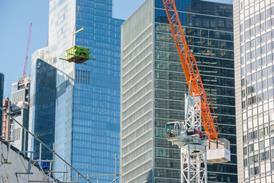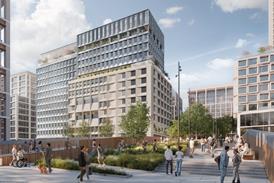- Home
- Intelligence for Architects
- Subscribe
- Jobs
- Events

Events calendar Explore now 
Keep up to date
Find out more
- Programmes
- CPD
- More from navigation items
Interview: Designing Britain’s biggest infrastructure project

By any standards and on any scale, it’s a huge job – and one with plenty of critics. HS2’s design director Kay Hughes tells Elizabeth Hopkirk she is relishing the unprecedented challenge
The last time that Kay Hughes and I met, we were politely waving each other on at a zebra crossing in south-west London – she a cyclist, I a pedestrian – before we recognised each other and stopped for a distanced chat. She had taken the afternoon off to clear her head and had ridden from her north London home to Horace Walpole’s exuberantly gothic Strawberry Hill villa.
It must have been a 30-mile round trip but for Hughes, who qualified as an architect in 1991 and worked for Denys Lasdun and Ted Cullinan before moving client-side 20 years ago, jumping on her bike is as much about learning as transport. A few months after the EU referendum she led a bunch of built-environment buddies on a cycling trip to the Netherlands to see what could be learnt from its urban extensions and infrastructure before the drawbridge went up.
In a letter home, published in Building Design, she wrote: “The headlines are: the UK should, in a time of limited resources, spend less time and money on regulating and administrating small issues and spend more on strategic planning, design-led delivery and leadership to achieve more effective outcomes.” Five years later her argument is more pressing than ever.
Several of the women on that trip, including Hughes, went on to win a National Infrastructure Commission (NIC) ideas competition for the Oxford-Cambridge corridor with their VeloCity proposal for a network of villages linked by public transport and cycle routes. Two years after that, in October 2019, Hughes was appointed design director of HS2 Ltd, the company tasked with building a £100bn high-speed railway connecting London and the North, giving her the chance to implement some of the ideas that she garnered on that Dutch study trip.
Now 18 months into the job, she spoke to Building Design about her ambition for this complex piece of national infrastructure and her conviction that its success will rest on the quality of the structures and landscapes they leave behind as well as a smooth passenger experience.
…
This is premium content.
Only logged in subscribers have access to it.
Login or SUBSCRIBE to view this story

Existing subscriber? LOGIN
A subscription to Building Design will provide:
- Unlimited architecture news from around the UK
- Reviews of the latest buildings from all corners of the world
- Full access to all our online archives
- PLUS you will receive a digital copy of WA100 worth over £45.
Subscribe now for unlimited access.
Alternatively REGISTER for free access on selected stories and sign up for email alerts






